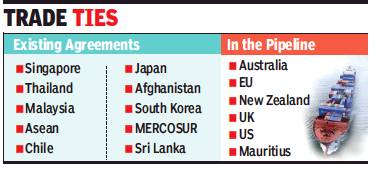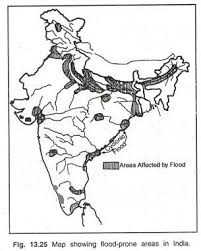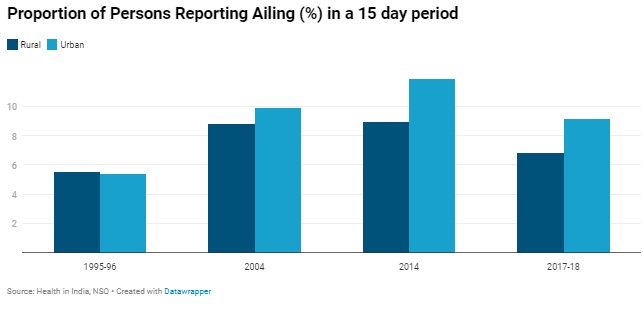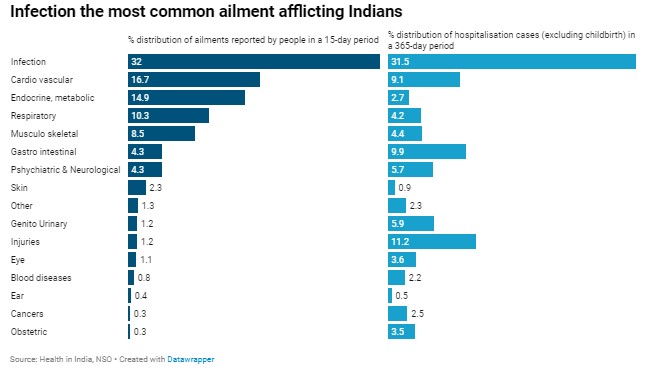Contents
- Govt to revamp FTA strategy to ensure economic benefits
- Monsoon fury in 8 states: Deployment of NDRF teams
- Fall in hospitalisations in 2017-18
- India Close to limited trade deal with U.S.
- China repeats claim on Bhutan’s east
- House panel: Social security number for migrant workers
- HIV/AIDS vulnerable groups petition global fund
GOVT TO REVAMP FTA STRATEGY TO ENSURE ECONOMIC BENEFITS
Focus: GS-III Indian Economy
Why in news?
Discussions have begun at the highest level leading the deliberations on a revamped strategy on Free Trade Agreements (FTAs), coinciding the External Affair’s minister’s statement that FTAs haven’t helped India build capacity.
Details
- The government is recalibrating its strategy on entering into free trade agreements (FTAs) in a bid to ensure that the treaties provide economic and strategic benefits.
- Separately, the focus is on alliances with “peaceful” countries, especially those with which India does not have a significant trade deficit.
- The finance ministry also has concerns over loss of revenue due to the trade agreements.
What is the concern raised?
- Free trade agreements are useful for expanding the country’s trade basket.
- But most treaties signed by India have failed to help domestic industry and have resulted in higher imports in several product segments, as local players are often uncompetitive.
How will different countries be considered?
- There is expected to be greater thrust to FTAs with Australia and the European Union, with the UK and the US among countries with which India will engage more aggressively, while recognising that there is no need to rush into a deal.
- There is eagerness to rework the agreements with ASEAN and Japan, as imports are seen to have gained more than exports due to a sharp reduction in tariffs.
- India was expected to benefit more on the services front, with software professionals and nurses getting easy access to markets such as Japan, Singapore, South Korea and Malaysia.
- What has complicated matters is the presence of Chinese companies in ASEAN countries, which use the benefit of lower tariffs to route goods into India.

What is a Free Trade Agreement (FTA)?
- A free trade agreement is a pact between two or more nations to reduce barriers to imports and exports among them.
- Under a free trade policy, goods and services can be bought and sold across international borders with little or no government tariffs, quotas, subsidies, or prohibitions to inhibit their exchange.
- Free trade is the opposite of trade protectionism.
- FTA allows businesses in each country to focus on producing and selling the goods that best use their resources while other businesses import goods that are scarce or unavailable domestically.
- That mix of local production and foreign trade allows economies to experience faster growth while better meeting the needs of its consumers.
-Source: Times of India
MONSOON FURY IN 8 STATES: DEPLOYMENT OF NDRF TEAMS
Focus: GS-III Disaster Managment
Why in news?
The monsoon has unleashed its fury in eight states causing more than 470 deaths due to floods and landslides, with the highest toll being recorded in West Bengal, Assam and Gujarat.
Details
- The calamity of Floods and Landslides in 8 states has resulted in deployment of at least 70 teams of the National Disaster Response Force (NDRF) for rescue and relief.
- In the current monsoon season, West Bengal has reported the highest flood-related deaths followed by Assam and Gujarat.
- In view of the outbreak of Covid pandemic, it is becoming increasingly challenging to maintain social distancing at relief camps.
- The UN office for disaster risk reduction (UNDRR) estimates that more than 26 million people globally are pushed into poverty every year as a result of climate change events.
- The Centre and states must prioritise disaster risk reduction as disasters are making India’s development highly risky and skewed with rising inequality.
The major causes of floods in India are:

- Meteorological Factors: Heavy rainfall; Tropical Cyclones; Cloud Burst.
- Physical Factors: Large Catchment Area; Inadequate Drainage Arrangement.
- Human Factors: Deforestation; Siltation; Faulty Agricultural Practices; Bursting of Dams; Accelerated Urbanisation.
Click Here to read more about the National Disaster Response Force
-Source: Times of India
FALL IN HOSPITALISATIONS IN 2017-18
Focus: GS-III Science and Technology
Why in news?
Latest survey on the state of India’s health by the National Statistical Office shows that – Fewer Indians reported ailments or required hospitalization in 2017-18 as compared to 2014.
Details
- The NSO Survey shows that the number of Indians reporting ailments dropped by more than 2% points in rural areas and more than 2.5% points in urban areas between 2014 and 2017-18.
- Interestingly, the proportion of those reporting ailments and those hospitalized rose between 1995-96 and 2014, according to three NSO surveys on health in this period.

Infection was most common ailment
- Infection the most cited reason for hospitalization, one in three ailing people reported having suffered an infection.
- Cardiovascular disease was the second most reported ailment, followed by endocrine and metabolic disorders (body’s over- or under-production of certain hormones and disorders affecting the body’s ability to process certain nutrients and vitamins), and respiratory diseases.
- However, when it comes to hospitalization, infection was also the leading cause for hospitalization.
- Although, cardiovascular disease was the second most reported ailment, it was the fourth biggest cause of hospitalisation.
- Trailing injuries and gastrointestinal diseases were the second and third most reported cause for hospitalization.

Other Findings
- A single case of hospitalization costs on average more than Rs 16 thousand in rural India and more Rs 26 thousand in urban areas (a difference of Rs. 10 thousand).
- Nearly 86% people in rural India and 81% in urban India are not covered by health insurance. As a result, about four in five Indians pay for hospitalization out of their household income or savings.
- More than 13% people in rural areas and more than 8% in urban areas borrow money to pay their hospital expenses.
- On average, a person who is hospitalized in India stays admitted for almost 7 days.
- But a person admitted to a private hospital is likely to stay admitted for a day more than a person admitted to a government hospital.
-Source: Hindustan Times
INDIA CLOSE TO LIMITED TRADE DEAL WITH U.S.
Focus: GS-III Indian Economy, GS-II International Relations
Why in news?
India and the U.S. have “almost” finalised a limited trade deal, Commerce Minister said.
Details
- Commerce Minister also reiterated what both countries have declared earlier — that the longer-term plan is to work towards a comprehensive trade deal.
- As an intermediate step between the imminent limited deal and the comprehensive deal, Commerce Minister proposed a preferential trade agreement with the United States that would cover 50 to 100 goods and services.
- The Commerce Minister is of the view that India should also look at an early harvest in the form of a preferential trade agreement so that India could look at an early harvest of maybe 50 or 100 products and services, rather than waiting for the gains of a Free Trade Agreement (which may take several years to conclude).
India’s Expectations
India wanted the U.S. to restore its access to the U.S. preferential trading system, the Generalized System of Preferences (GSP), an end to Mr. Trump’s steel and aluminium tariffs, increased market access for some categories of Indian agricultural products and so forth.
U.S.’s Concerns
U.S. concerns during the negotiations have included market access for American dairy and agricultural products, medical devices and a cut in information and communication technology (ICT) import tariffs. The U.S. has also had concerns with India’s digital trade policies (for instance FDI in commerce, data localisation).
In other news: US open to talks on security tax burden on Indian professionals
- The US has finally agreed to discuss with India differences over a social security tax levied on Indian professionals employed in America – the first step towards reaching an agreement that could allow Indians working in the US to be repaid social security deposits when their work visas expire.
- According to an industry estimate, Indians working in the US forfeit almost $1 billion annually in social security tax.
- For the first time in almost a decade, the US recently acknowledged that social security tax is a bilateral issue and agreed to discuss it.
- Indian workers, particularly information technology (IT) professionals, make social security contributions in the US when they work there, but most of them come back home before they are eligible to withdraw money from their social security contributions.
-Source: Hindustan Times, The Hindu
CHINA REPEATS CLAIM ON BHUTAN’S EAST
Focus: GS-II International Relations
Why in news?
China said that it has offered Bhutan a “package solution” to its boundary dispute, reviving a reference to its 1996 proposal for a territory swap to give Bhutan the disputed areas in its north in exchange for the disputed western areas, including Doklam.
Forcing a Border Settlement?
- The Chinese Ministry of Foreign Affairs (MFA) also repeated its claim on Bhutan’s eastern boundary at Sakteng, which experts warn, maybe a new pressure tactic by Beijing to push Thimphu into concluding a boundary deal.
- The boundary between China and Bhutan is yet to be demarcated, and the middle, eastern and western sections of the border are disputed.
- Since 1984, when China and Bhutan began talks, the areas of dispute have only included Pasamlung and Jakarlung valleys to the north (what China calls middle) area, and Doklam and other pasturelands to the west.
- The eastern boundary of Bhutan, which borders Arunachal Pradesh, has never been in contention.
- What is important to note is that according to Bhutan, the Sakteng area in the east was never brought up in the several rounds of border talks with China.
Click Here to read about China’s Claims of the Sakteng Area
-Source: The Hindu
HOUSE PANEL: SOCIAL SECURITY NUMBER FOR MIGRANT WORKERS
Focus: GS-II Social Justice
Why in news?
The Parliamentary Standing Committee on Labour has recommended that the government introduce a social security number for migrant workers, especially those working in the unorganised sectors which are beyond the purview of the labour laws.
The Rationale Behind the recommendation
- Such a number is essential to avert situations like the one during the extended lockdown when several lakh workers had to walk back to their homes as they were shut out of employment overnight.
- The members felt that the Aadhaar number alone doesn’t work. A social security number will not only help in mapping the number of migrant workers and their migration patterns.
- The Labour Ministry was unable to give any concrete figures on number of migrant workers.
Detailed records
- The panel has recommended that both the State of origin and State where the worker has migrated to should have a record.
- They also pointed out that the government’s Social Security Code Bill 2019, which is under the committee’s consideration provides for a social security fund.
- But there are no specific details in the legislation as to who will contribute to the fund and how will it be utilised.
What is Social Security?
Social security is “any government system that provides monetary assistance to people with an inadequate or no income”.
It refers to the action programs of an organization intended:
- to promote the welfare of the population through assistance measures guaranteeing access to sufficient resources for food and shelter and
- to promote health and well-being for the population at large and potentially vulnerable segments such as children, the elderly, the sick and the unemployed.
Services providing social security are often called social services.
-Source: The Hindu
HIV/AIDS VULNERABLE GROUPS PETITION GLOBAL FUND
Focus: GS-II Social Justice
Why in news?
Deprived of sources of livelihood during the pandemic, sex workers, transpersons, gay and bi-sexual men, drug users and people living with HIV/AIDS have petitioned the Global Fund for AIDS, TB and Malaria (GFATM) protesting against being ignored by government and multilateral agencies in coronavirus (COVID-19) related emergency relief efforts.
Details
- The petition on behalf of “key populations affected by HIV/AIDS” or KPs have sought allocation of funds to meet their basic survival needs for food, shelter and emergency medical care as many find themselves without work and displaced due to lockdown restrictions accompanying the pandemic everywhere.
- The petitioners urge the GFATM to issue guidance to governments to channelise their COVID-19 relief funds to emergency survival needs of KPs.
Global Fund to Fight AIDS, Tuberculosis and Malaria (GFATM)
- The Global Fund to Fight AIDS, Tuberculosis and Malaria (or simply the Global Fund) is an international financing and partnership organization that aims to “attract, leverage and invest additional resources to end the epidemics of HIV/AIDS, tuberculosis and malaria to support attainment of the Sustainable Development Goals established by the United Nations”.
- This multistakeholder international organization maintains its secretariat in Geneva, Switzerland.
- The Global Fund is the world’s largest financier of AIDS, TB, and malaria prevention, treatment, and care programs.
- The Global Fund is a financing mechanism and NOT an implementing agency.
- Programs are implemented by in-country partners such as ministries of health, while the Global Fund secretariat, whose staff only have an office in Geneva, monitor the programs.
- The model has also raised concerns about conflict of interest, as some of the stakeholders represented on the Country Coordinating Mechanisms may also receive money from the Global Fund, either as grant recipients, sub-recipients, private persons (e.g. for travel or participation at seminars) or contractors.
-Source: The Hindu





